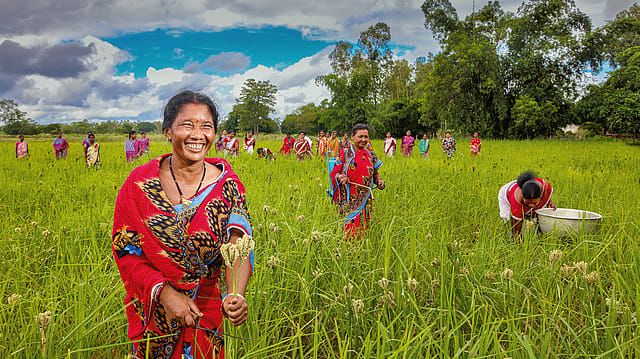Odisha's Women Milletpreneurs
ADVERTISEMENT

Cookies in 45 flavours, cakes, porridge mixes, pasta, rasagulla and gulab jamun, made of finger millets or ragi. The menu also includes products such as bajra and jowar flour. Millets (ragi, bajra, jowar, foxtail and barnyard) are a rage in most upmarket Indian homes. Since they are healthier and contain far more nutrients than rice and wheat (millet crops have high micro-nutrients like iron and zinc and a low glycemic index that is good for people with diabetes), well-to-do Indians are switching to millets. However, these millet cakes, pasta and bajra powder are not part of a premium food brand. They are produced by Dibyajyoti SHG, a self-help group run by 80 women in the tribal district of Sundergarh in western Odisha. That's not all. Dibyajyoti SHG has recently clocked a revenue of ₹1.5 crore and its products have even made it to international food fairs. While the Government of Odisha is its biggest client, Dibyajyoti also supplies its products to corporates and private educational institutions. Women members of this self-help group take home nothing less than ₹10,000 a month and have been able to bring their families out of poverty.
The millet menu gets fancier in the remote mining town of Keonjhar. Ganga Singh, founder of the 10-member Krishna SHG, says that ragi chicken momo is her bestseller. Singh has replaced the maida or rice-flour exterior of momos with ragi. Her ragi custard, foxtail fried rice and ragi chicken manchurian are popular too. Her ₹25 lakh venture caters to the Millet Café set up on the premises of the collectorate and takes up several party orders. "I even supply millet snacks to Government offices in Bhubaneswar," says Singh.
The Odisha Millet Mission (OMM) has 1,500 such women-led self-help groups through which it is building the millet narrative in the state. It's well-known that India is at the forefront of millets promotion globally and the state governments have instituted millet missions. "Odisha already had a programme called Mission Shakti which empowers women with financial independence. Throughout the value chain, we have involved women self-help groups because if you involve the community from the beginning they feel they have a stake in the game," explains Arabinda Padhee, principal secretary (department of agriculture and farmers' empowerment), Government of Odisha.
January 2026
Netflix, which has been in India for a decade, has successfully struck a balance between high-class premium content and pricing that attracts a range of customers. Find out how the U.S. streaming giant evolved in India, plus an exclusive interview with CEO Ted Sarandos. Also read about the Best Investments for 2026, and how rising growth and easing inflation will come in handy for finance minister Nirmala Sitharaman as she prepares Budget 2026.
So, if 10 farmers in a village own 2-3 acres of land, they are encouraged to give a small portion of their land to their wives to grow ragi or mandiya (the most popular millet in the state). The government not just procures from these women farmers at MSP (₹3,500-₹3,578 per quintal), it also incentivises them with an additional ₹10,000 per hectare for the first five years. A major part of the millet mission's goal is to increase consumer awareness and Padhee feels that since women are caregivers the women-led SHGs would help in popularising millet consumption.
Ratnabala Mohanto, founder of Maa Jogeshwari SHG in Keonjhar along with her 12 women partners started cultivating ragi in 2019 over a stretch of six acres land. They have on an average been producing 2-3 quintals of ragi which they are not only using for themselves, but they are also selling to the government and in the mandi. "Every female member manages to earn ₹4,000-5,000 during the harvest season. We have now decided to set up machinery to make flour and other value-added products like mixture and ganthia," says Mohanta. Incentivised by the success of ragi, the self-help group has also forayed into vegetable cultivation. "We are growing potatoes, cauliflower, capsicum and cabbage and the SHG is able to earn an additional income of ₹60,000-₹1 lakh per year," Mohanta further claims.
The Odisha Millet Mission, says Padhee, which currently operates in 143 blocks of the state will spread its wings to the entire state in 2023. "In last five years it has reached out to nearly 1.6 lakh farmers through crop demonstrations and technology adoption. The area under millet cultivation was 2.18 lakh hectare in 2007-08, it decreased to 1.39 lakh hectare in 2016-17 and now it is increasing and gaining its lost respect. Last year millet was grown in 1.87 lakh hectare," Padhee further explains. He expects to end 2022-2023 with ragi yield of 6.25 lakh quintals as opposed to 3.25 lakh quintals in 2021-22. "Our target is to move to one million quintals."
When OMM was launched in 2017, the state government invested ₹60-65 crore per year which in the last couple of years has increased to ₹360 crore per year. The state government, says Padhee, has allocated ₹ 2,808 crore for the next six years. From doing promotions in the upcoming Hockey World Cup to partnering with corporate houses, Padhee says that OMM would go all-out to make millet consumption mainstream.
"There is a growing demand for millet-based products and business principles tell me that with growing consumer demand the market forces will align. We already have 100 farmer producer organisations (FPOs) and we will scale up our production so that there is a huge supply for the market forces."
